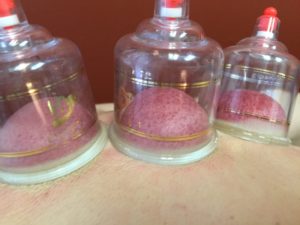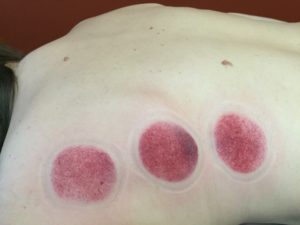Cupping
The ancient art of cupping is used today by healers and lay people in many cultures, and has been for many years. It even caught the attention of the WALL STREET JOURNAL in November 2012. It is a suction technique designed to pull toxin build-up and muscle spasm from the body’s deeper tissues to the surface of the skin. The cells of the body use oxygen and give off carbon dioxide; when the energy is blocked, the cell waste or carbon dioxide gets blocked. This is known as acid or toxin build-up. Physical pain implies a blockage in the flow of energy through a particular area. When toxins or cell waste stagnate in the muscles or joints, it can be challenging for the body to rid itself of this waste, causing further blockage and discomfort. Cupping by vacuum or suction pulls the blockage out of the deeper tissue and moves it to the skin’s surface. Once on the surface, it is much easier for the body to eliminate toxins through the superficial blood supply or capillary system. In only ten minutes of cupping, we can pull OUT toxin build-up from a specific area as well as PULL fresh new blood into those areas to restore proper blood circulation and vitality.
Cupping is diagnostic as well as therapeutic. It describes the LOCATION of the problem, what KIND OF PROBLEM it is and the SEVERITY of the problem.
LOCATION: We usually cup an area that is slightly larger than the painful region in order to ensure that the pain is completely addressed. Some skin under the cups will color, and some won’t, although the same amount of suction has been used with all cups. Even on the skin under a single cup, one part may color while the rest may not. These colored areas help us identify the source of discomfort.
THE KIND OF PROBLEM: Pain relating to toxin build-up or muscle spasms will cause the skin under the cup to color. But if the pain is related to bone or nerve, it will not color at all. Some pain is a combination of muscle and nerve, and cupping will help alleviate the muscular portion of the problem, but the bone and/or nerve issue will still need to be dealt with at another time.
SEVERITY: Light or moderate blockage will cause the skin under a cup to color pink or red, and it will take a day or two for it to fade. Severe stagnation may cause the skin to color a deep scarlet, purple or even black; it may take 7 to 10 days for the dark color to disperse.

WHAT DOES IT FEEL LIKE? The first minute can be a bit painful; this is the time when most of the toxins are being removed. It is helpful for the patient to relax and breathe, and to acknowledge and tolerate the pain. The practitioner should watch the patient carefully, make sure the patient does not hyperventilate, and encourage them to inhale and exhale only through the nose (this slows the breathing and prevents light-headedness and dizziness). The discomfort usually eases after a minute. Patients who are lying down while receiving cups may even doze off.
HOW LONG DOES IT TAKE? Cups rarely need to be applied for more than 10 minutes. If no color appears, cups can be removed and relocated until the treatment is deemed complete.
AFTER CUPPING: It is important to rest for at least 48 hours after receiving cups. Strenuous activity and working out should be avoided. Drinking a lot of water helps flush the toxins out of the muscles. The cupped area should be kept covered and/or away from drafts; this is particularly important if the neck has been cupped. One should not sleep under a fan or next to an open breezy window after being cupped. The cupped area may be tender to the touch. So you must factor your treatment into your activities and adjust accordingly. Your practitioner will go over the specific care needed for your cupping treatment.
Cupping is an extraordinary technique, and its effects are immediate. The healing process may be shortened by weeks or even months by using cupping. It manually removes energy blockages in ways that acupuncture needles cannot.
I am grateful to Susan Johnson, L.Ac. for sharing her wisdom and words about cupping.
